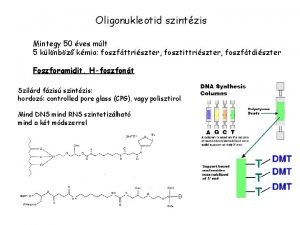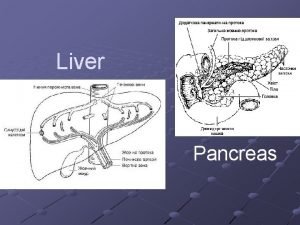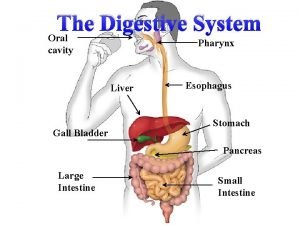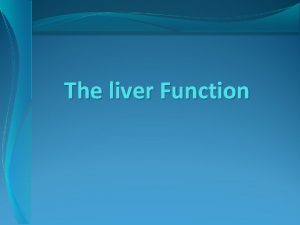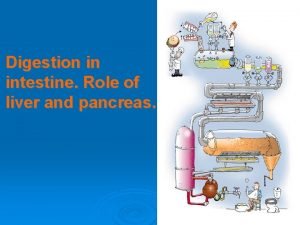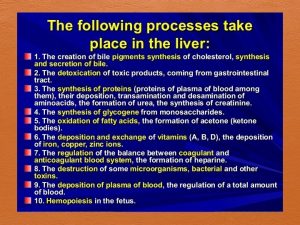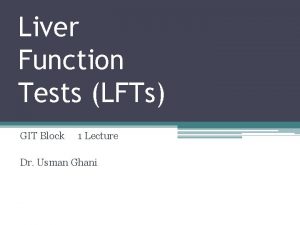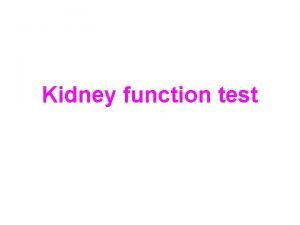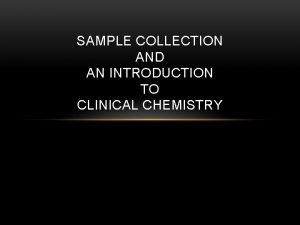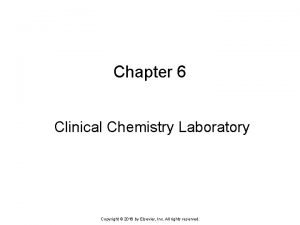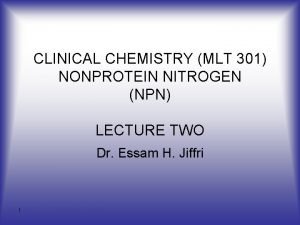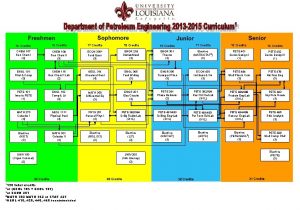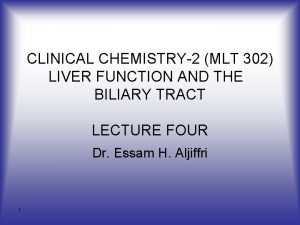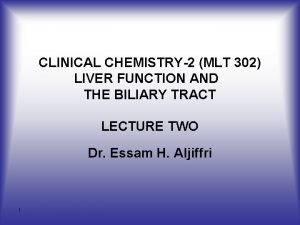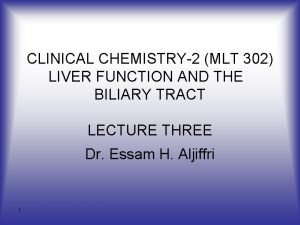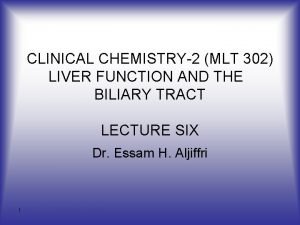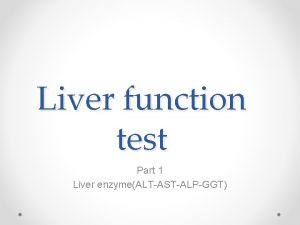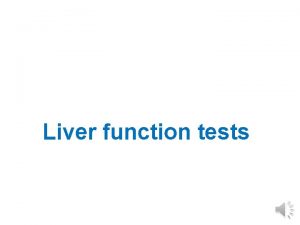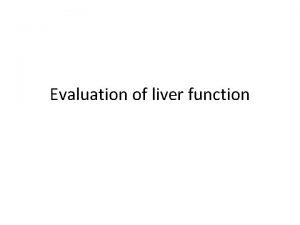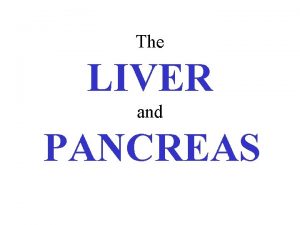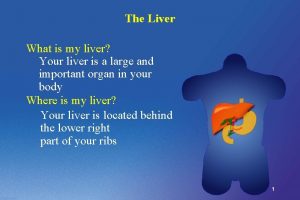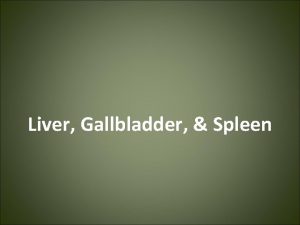CLINICAL CHEMISTRY 2 MLT 302 LIVER FUNCTION AND



















- Slides: 19

CLINICAL CHEMISTRY 2 (MLT 302) LIVER FUNCTION AND THE BILIARY TRACT LECTURE FIVE Dr. Essam H. Aljiffri 1

LIVER DISEASES Acute Viral Hepatitis • Hepatitis occurs as a complication of many viral infections, the term viral hepatitis usually refers to three types of infection (A, B and C). • Hepatitis A is transmitted by the oro faecal route while; Ø hepatitis B and C are transmitted by blood products or other body fluids. • Attacks vary in severity and may be asymptomatic with only a transient rise in transaminases. 2

Acute Viral Hepatitis • The basic pathology of these infections is similar; Ø acute inflammation, and Ø hepatic necrosis occurs. • Symptoms are often non specific at presentation, including; Ø Anorexia, and Ø Nausea. 3

Acute Viral Hepatitis • Serum transaminases may be elevated significantly, sometimes exceeding 20 times the upper limit of normal. • Serum transaminase activities usually peak before the onset of jaundice which occurs typically 34 days following the onset of symptoms, • the urine often becoming dark and the feces pale. 4

Acute Viral Hepatitis • Impaired excretion of bilirubin from hepatocytes is often the major cause of hyperbilirubinaemia which is therefore mainly conjugated. 5

Acute Viral Hepatitis • Bilirubinuria is common. • Modest increases in alkaline phosphatase greater than three times the upper limit of normal. 6

Chronic Hepatitis • Chronic persistent hepatitis may follow acute viral hepatitis. • Transaminase activities often being abnormal biochemical finding. 7

Chronic Hepatitis • Chronic active hepatitis may result from persisting: Ø Ø Ø 8 hepatitis B infection, other viral infections, auto immune hepatitis, drug reactions, alpha 1 antitrypsin deficiency, alcohol abuse.

Chronic Hepatitis • Jaundice with very high serum transaminase activities is common; Ø immunoglobulin levels are often high. • Serum albumin concentrations may fall as the disease progresses. 9

Hepatic Cirrhosis • Cirrhosis is a diffuse process in which fibrosis and nodule formation follows: Ø hepatocellular necrosis. • There are many causes: 10

Causes of liver cirrhosis • Chronic alcohol abuse • Viral hepatitis • Inherited metabolic disorders Ø Haemochromatosis Ø Wilson’s disease Ø Galactosaemia Ø α Antitrypsin deficiency Ø Tyrosinaemia Ø Type IV glycogen storage disease • Prolonged cholestasis • Hepatic venous outflow obstruction Ø Heart failure • Toxins, drugs 11

Hepatic Cirrhosis • The normal architecture of the liver is disrupted in cirrhosis, with changes in the blood supply resulting in portal hypertension. • Slight increases in transaminases, particularly AST and GGT, are the commonest abnormalities 12

Hepatic Cirrhosis • Jaundice is accompanied by increased urobilinogen and bilirubin excretion in urine. • Increases in serum immunoglobulins may occur. • Patients with cirrhosis are at increased risk of developing: Ø hepatocellular carcinoma, indicated by ( high alpha fetoprotein concentrations in serum). 13

Hepatocellular and Acute (Fulminant) Hepatic Failure • Hepatocellular failure may result from almost all causes of liver disease including: Ø viral hepatitis, Ø cirrhosis, Ø drug overdoses, e. g. paracetamol, and • prolonged cholestasis. • Jaundice is often progressive and transaminases are usually raised. 14

Hepatocellular and Acute (Fulminant) Hepatic Failure • Changes in nitrogen metabolism occur, including: Ø reduced urea synthesis and Ø Blood levels of ammonia may rise. • Hypoglycaemia may occur owing to impaired gluconeogenesis. • Abnormalities in oestrogen androgen metabolism occur and a degree of feminization is common in male patients. 15

Hepatocellular and Acute (Fulminant) Hepatic Failure • Testicular atrophy is common, with reduced testosterone level, particularly in: Ø alcoholic patients. • Fulminant hepatic failure is caused by: Ø sudden massive necrosis, or Ø severe impairment of liver function. 16

Hepatic Malignancy • The liver is a common site for secondary carcinoma. • Increases in serum alkaline phosphatase and GGT due to: Ø tumours causing cholestasis in parts of the liver are common abnormalities of liver function tests. 17

Toxic Liver Damage • Liver injury may follow exposure to a number of: Ø pharmacological, or Ø chemical agents. • With some, toxic effects are predictable and dose related. 18

Gallstones • Most gallstones, unlike renal stones, do not contain calcium and are: • radiotranslucent. • The main constituent of gallstones in Western countries is cholesterol. - Cholesterol gallstone formation due to: Ø supersaturation of the bile with cholesterol. 19
 Xuele.moe.edu.sg/xuele/moe web/main.html
Xuele.moe.edu.sg/xuele/moe web/main.html Mlt 5
Mlt 5 Liver and pancreas function
Liver and pancreas function Pharynx in digestive system
Pharynx in digestive system Gilbert syndrome lab values
Gilbert syndrome lab values Synthetic function of liver
Synthetic function of liver Gallblader function
Gallblader function Function of liver physiology
Function of liver physiology What is the primary function of the liver
What is the primary function of the liver Normal lft
Normal lft What is bilirubin
What is bilirubin Function of kidney
Function of kidney Introduction to clinical chemistry
Introduction to clinical chemistry Osmolarity formula
Osmolarity formula Persenyawaan
Persenyawaan 7285 x 302
7285 x 302 A 302
A 302 Mat 302 bmcc
Mat 302 bmcc Difference between growth and development
Difference between growth and development Eee 302
Eee 302

